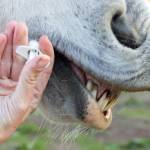Handling Horses: Stay Safe

One of the first and most important lessons a young foal learns is that while it’s all right for a human to enter the horse’s personal space and touch the horse all over, it’s not all right (and won’t be tolerated) for the horse to invade the person’s space or touch the person, especially in a threatening or aggressive manner. This lesson is reinforced every day as the horse is led, groomed, and eventually tacked up and ridden. Most horses do pretty well under normal conditions, and humans can become complacent as they move around these incredibly powerful half-ton creatures. A problem often arises, however, when owners or veterinarians try to carry out a necessary procedure that may be painful, frightening, or in some way threatening to the horse. This might be treating a wound, trimming hairy ears, or even giving an oral dewormer or electrolyte. Ideally, the horse will have been handled enough to develop trust in the handler, and many horses will put up with quite a lot of threat or discomfort as long as the owner is there, but most horses will take only so much before they begin to show resistance by biting, kicking, rearing, or pulling away. At this point, some sort of restraint, either physical or chemical, is necessary to prevent injury to the horse and its handlers.
Owners need to become familiar with signs that stress is building and the horse is reaching the limit of his patience. These include a tucked-up tail (a fear reaction) or a lashing tail (an angry reaction); a hind foot cocked up or raised; nostrils that appear tight or pinched partly shut; and tightness around the face and lips. Eyes showing a lot of white border might be a sign of fear, and ears that are pinned back are an indication of serious displeasure and possible aggression. If a horse begins to show these signs, it’s time to back off for a while and consider physical restraint.
Correct use of a lip twitch can be helpful. The twitch should be put on gently and tightened firmly but not so as to injure the horse. Then, wait three to five minutes if possible to let the twitch-cued endorphins do their work. Take the twitch off as soon as the procedure is finished, as the calming effect of the endorphins lasts only about ten minutes.
Using animal stocks can take much of the risk out of procedures that may provoke dangerous behavior in a horse. Stocks allow a horse to be confined in a small area while veterinarians or owners have safe and unimpeded access to give injections, clean and stitch lacerations, palpate mares, perform artificial insemination, float teeth, and perform other necessary chores that the horse may object to. When choosing a spot to put stocks in a barn, look for an area with good access, good lighting, and easy access to water and electricity.








